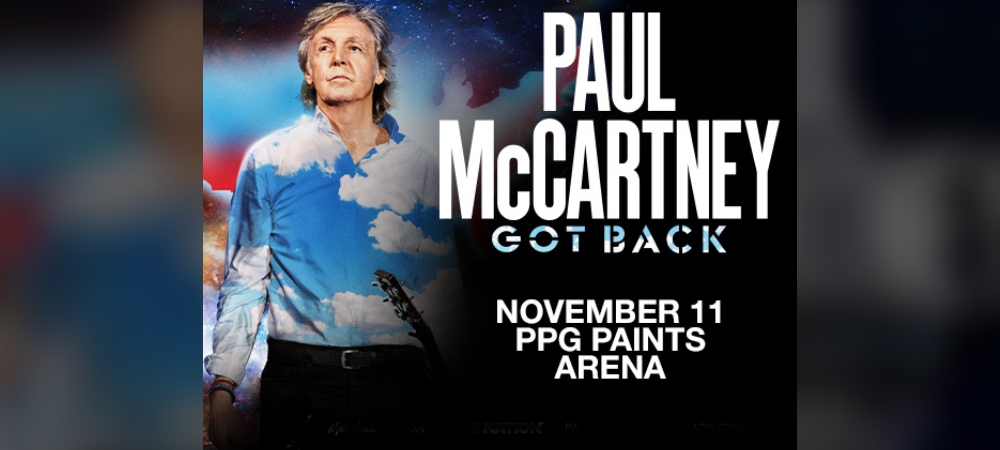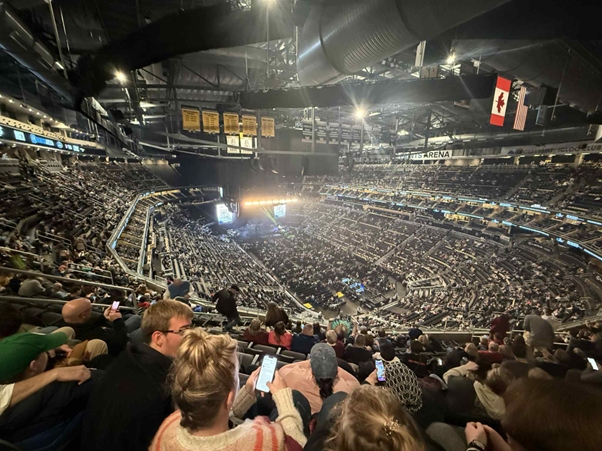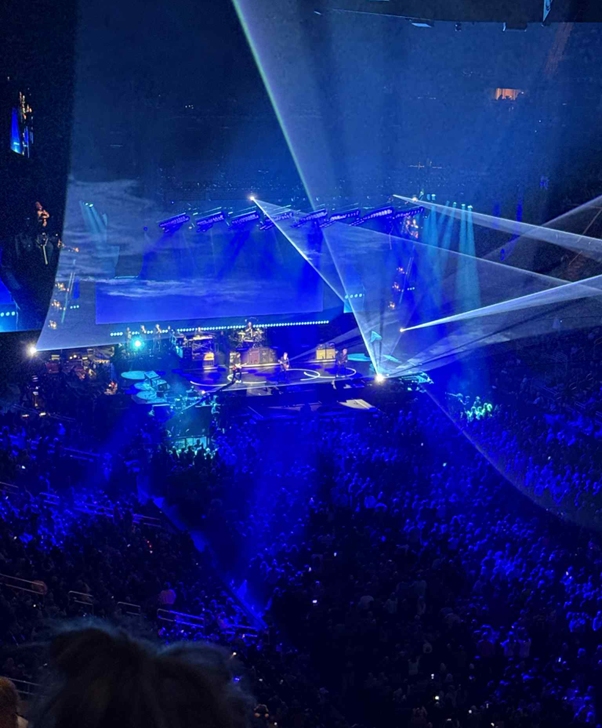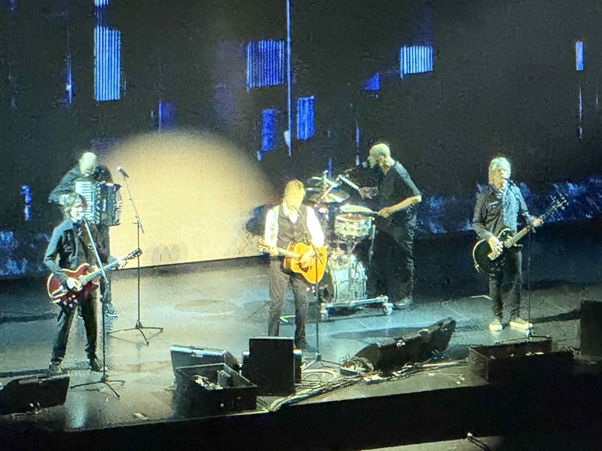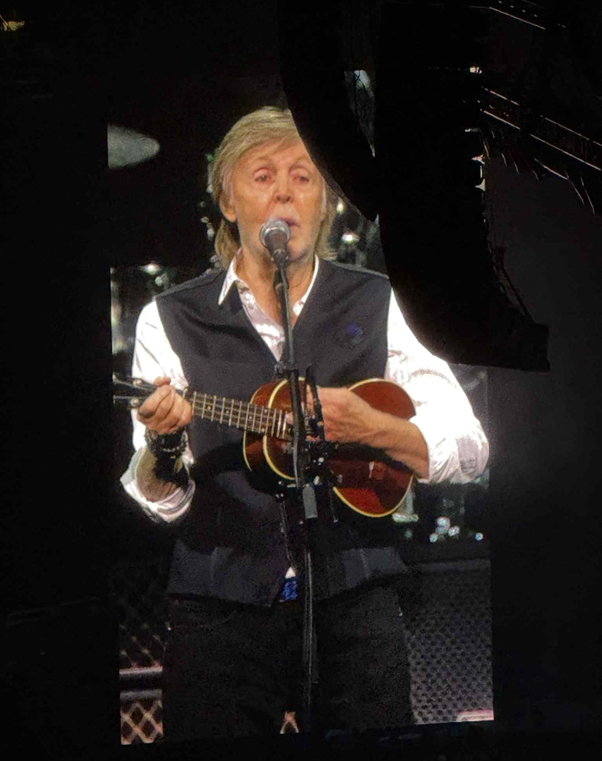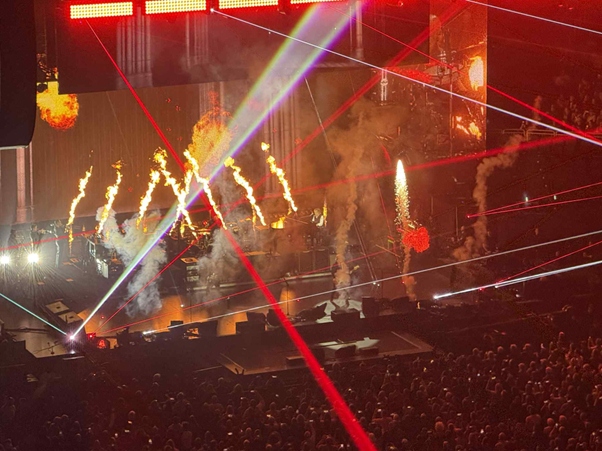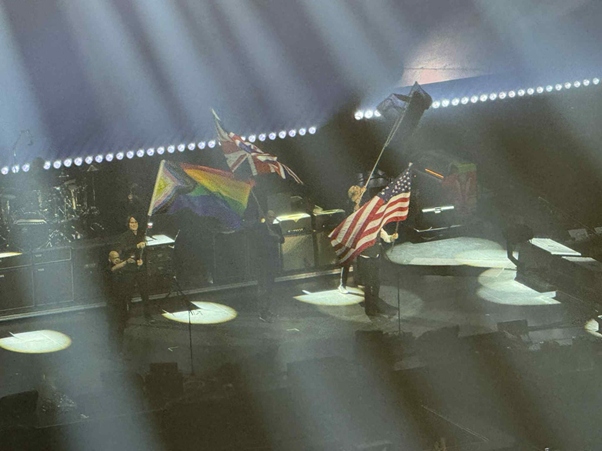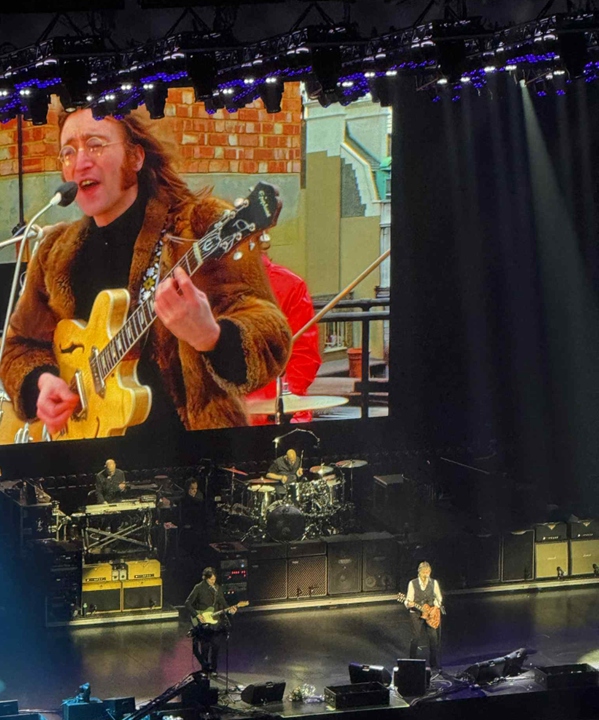PPG Paints Arena, Pittsburgh, PA
Tuesday, 11th November 2025
When we think about the Beatles, we tend to imagine the happy-go-lucky, mop-topped lads from Liverpool (please) pleasing multitudes of fans in packed-out stadiums or gallivanting through psychedelic adventures in a long-ago era, safely trapped in history where nothing can touch them. In the disastrous geopolitical epoch that we are struggling through, it’s quite jarring to think that half of those lads have survived long enough to experience all this with us.
We don’t tend to associate the Beatles with Brexit, for example, but it was pretty disheartening to see that Ringo, quite antithetical to his constant “Peace and Love” messaging, was very pro-Brexit and has been since, while Paul simply said he was “confused”. Who would imagine that these two would also live through a pandemic and find out that Trump was elected president not once but twice? In some ways, I feel grateful when beloved celebrities die because at least they don’t have to experience any more of the drudgery of modern life; when COVID hit, I remember thinking, “At least Neil Peart doesn’t have to see this.”
But so it is that Paul McCartney is still with us, and still drawing huge crowds to his shows a full six decades after his heyday with the Beatles. It’s quite astonishing, really. Because I’ve been travelling so much in the last decade, I’d always missed out on his shows and I’d practically ruled out any chance of seeing him in my lifetime (or indeed, his). But when his Got Back North American tour was announced, it sparked within me a burning excitement. This could finally be my chance!
By the way, reader, if you simply want to find out how the concert itself was, you’ll want to skip ahead a few paragraphs, because this is where I do my storytelling.
I looked at the dates. Damn, no date in DC. Where’s closest? Pittsburgh?! How far away is that? 250 miles, or five hours… that could be doable. Just as Muslims had their Hajj to Mecca, I would complete my pilgrimage to Macca. And what are the ticket prices?
My jaw dropped when I saw this next bit. I’ll be quite candid and reveal that the nosebleed seats that I got were roughly half a grand, in dollars, about ten times as much as I was used to paying for a concert ticket. I asked myself if this was really worth it, but I knew in my heart that I owed it to myself to witness this concert and satiate the fan in me that had loved the Beatles since childhood. This was a once-in-a-lifetime event.
To keep this venture from ballooning in budget anymore, I decided to be rock-and-roll about transport and accommodation, taking the Greyhound bus through the Appalachian mountains by day to get there, and returning the same way, skipping accommodation for a 24-hour adventure. Things were made more complicated by the Arena’s ‘no bag’ policy, meaning I couldn’t pack anything like a pillow or extra food. As a result, I didn’t even bring a mains adapter, as I had presumed the bus would have USB ports for charging phones, but no such luck. Instead, I had to make do with the two battery packs and be economical with my phone usage. I bought a plastic bag with a homemade sandwich and some snacks, which I ate on the bus and disposed of at the Pittsburgh station so that I wouldn’t be contravening any rules.
The bus ride to Pittsburgh was long and winding, with nearly three hours added to the ride time as the route travelled via Baltimore, York and Harrisburg. I didn’t know this when I boarded the bus, and started to panic when I saw on Google Maps that we were travelling completely the wrong way. The route was quite scenic, though, with the low Appalachians making for some splendid sights. On the way, I didn’t quite feel like listening to Beatles music as I knew the songs so well; instead, I played songs by the Rutles and their loving pastiches of music by the Fab Four. I Must Be in Love was a particular highlight, with a melody and chorus so authentic that it felt as if it could have fit in perfectly on A Hard Day’s Night.
The weather in Pittsburgh was much colder than in DC, so I was wearing three layers. Snow had been forecast for later that evening, which didn’t seem fair given that it wasn’t even winter yet. I had two hours to kill before the concert, so I stopped at a taco bar for some sustenance before doing a little more night tourism just to see Pittsburgh, as I had never been here before (and was not sure if I’d return). The city lies at the confluence of two rivers, and I walked to the very end of Point State Park to see where two become one. The park, surely a tourist hotspot during the day, was deserted at the pitch dark of 6:30 PM, and I was able to enjoy the massive space to myself, with the Allegheny on my right and the Monongahela on my left, forming the Ohio River that rippled in front of me.
This oasis of calmness felt very much needed before I faced the throng of thousands of fans waiting to enter the PPG Paints Arena. Large signs read, “Welcome back to PPG Paints Arena, Paul!”, and I discovered he’d actually been the first artist to play at this venue with two performances in 2010, when it was known as the Consol Energy Center. He’d also played here in 2014. Prior to that, he’d played at the futuristic Civic Arena with the Beatles in 1964 and on his first solo world tour in 1990. This arena had an incredible, giant circular dome that could open to reveal the sky, but it was sadly demolished in 2010.
There was no orderly queue, although some polite patrons had opted to form a long, long, long queue that stretched around the block. I had to fight my British upbringing not to join the longest part of the queue, and simply joined at the main hub. Here, I once again saw the “No bags” policy, but I overheard an elderly security man say that it was rubbish, because they did allow bags that had been x-rayed. So it seemed the policy was more of a deterrent than a rule. I also saw a lady ahead of me pull out her binoculars to show to security, which they okayed. I winced and thought that would have been a good idea.
When I did get inside, it took me another ten minutes just to find my seat, located high, high up and all the way at the back. The space was vast, the second-largest indoor arena I’ve visited (the first being the O2). The capacity was around 15,000 people, and only a handful of these were behind me; I’ve visited cities with smaller populations than this. As the time wore on, every one of these seats became filled; this giant arena had become completely packed.
At last, it was go time, and Paul and his fellow musicians entered the stage, mere specks in my field of vision. I’ve been praised by my doctors for having exceptional eyesight, but I couldn’t make out anything other than a suited man playing a guitar. If it weren’t for the giant screens that showed a live feed of McCartney playing, it could have just as well been anyone else.
This bothered me a lot more than it should have. Suddenly, I longed to have those binoculars and cursed myself for not bringing them. How was it possible to drop $500 on a concert ticket and still feel like a poor person because you can’t even make out the person’s face without a giant screen? I tried to let it go, but dreams and schemes of moving to an aisle closer to the stage began to haunt me. I stayed in my seat, though, as I didn’t see myself as more special than anyone else in my section, none of whom appeared to be squirming to get a closer glimpse.
That being said, there was one fellow who would get up from his seat and actively dance to his favourite Beatles and Wings songs before whooping loudly at the end. I know he was enjoying himself, but it didn’t seem respectful to the people in front of him. I was glad to be a few seats back.
McCartney opened with Help!, the first song that I associated with the Beatles (before I discovered that so many of the songs I learned to sing in my primary school music lessons were also by them). My dad had bought a pirated DVD of the film Help! when we were on holiday in Thailand. The first time we watched it, I was utterly transfixed by these funny, charismatic men and their great music. It was love at first sight. All these years later, the crowds’ cheering managed to drown out some of the sound, and I was a little disappointed at the sound quality in the nosebleed area; it was difficult to rate McCartney’s voice, and the initial upset at how far I was from the stage still hadn’t worn off.
It was good to see all these fans still cheering for Beatles music, though. I’m not quite sure what I’d expected the demographics to be (except that people would need a lot of disposable income just to attend this event), but I was still quite surprised to see so many young people at this concert when Steve Hackett’s crowd just two weeks earlier had been mainly of the white- and wispy-haired variety. It’s a joy that Beatles music still resonates with new generations all these years later, and one wonders if they might ever fall out of fashion.
While the Beatles have been the bread and butter of my music catalogue for two decades, finding the courage to try their solo work has always been difficult for me. While gems exist in each of their discographies, the quality rarely comes close to what the band captured when they were together. Still, I knew I couldn’t attend this concert without doing some further research, and I enlisted the use of ChatGPT to help make a spoiler-free playlist of songs McCartney might play on this tour. Only a few songs really captured me: the light disco-inflected Silly Love Songs, the profoundly Beatles-esque New and the bizarre, comedic Temporary Secretary. Unfortunately, he didn’t play any of those.
Instead, he continued with Coming Up from McCartney II, a rather light and inconsequential pop song, before engaging in some banter with the audience. This banter eased my anxiety about not being able to clearly see Paul, as I remembered I was there to ‘be in a room with him’ and experience his personality. For all his faults (Peter Jackson’s seminal Get Back documentary proved just how bossy Paul could be in the studio), McCartney is an exceptional entertainer. He knew just the right things to say to get a crowd going, complimenting the audience and saying they were going to have a fun night. If these moments were rehearsed, they didn’t seem like it.
He mentioned that there would be new songs, old songs and songs that were somewhere in between. He teased the audience by saying, “This one definitely isn’t new”, before launching into Got to Get You into My Life, a great song musically, but one that has been cheapened for me after I learned that the ‘You’ in the song title refers to marijuana and not some great love.
More tunes followed, the classic Drive My Car, the first Wings song of the evening Letting Go and one that almost nobody in the audience had heard before, Come On to Me, from his 2018 album Egypt Station. He even made a joke that they were going to play a song and that anybody who knew it should join in, and anyone who didn’t… tough, they were going to play it anyway, sensing that it wouldn’t be as popular. I’d rather he had played Fuh You, the one song from that album that was outrageous enough to make its way to me back when that album was released.
Next was Let Me Roll It, returning to a more laid-back Wings tune before finishing with a musical reference to Jimi Hendrix and an anecdote, too. That seemed to be about as many non-Beatles songs in a row as McCartney could get away with, so he delighted the audience with the classic Getting Better. It’s not a song that’s aged gracefully, as the verse that mentions “I used to be cruel to my woman, I beat her and kept her apart from the things that she loved,” could never be written today, and is a self-indictment by John Lennon. I thought Paul might skip this verse entirely, but he didn’t; perhaps it would look more suspicious if he took it out. It’s a great song, and I liked the new ending that the band came up with to account for the song’s original fade-out.
Song number nine, number nine was another slow, repetitive, but somewhat fun Wings track: Let ‘Em In (I’m still not quite sure what it’s about, or why it’s so repetitive). Then, Paul introduced My Valentine, a love song with an unusually sombre tone, that he’d written for his current wife Nancy, whom he revealed was in the audience that evening. The song was met with polite applause, and I wondered if this meant he’d refrain from playing any songs dedicated to Linda.
Well, that turned out not to be the case. Paul took this opportunity to wander over to the grand piano at the back of the stage, and after a stomping rendition of Nineteen Hundred and Eighty-Five, he played one of his most enduring songs ever: Maybe I’m Amazed. I had thought that Paul’s band was perfectly adequate up until this point, playing faithful renditions of his old songs. But with this tune, they absolutely cooked, increasing the drama and soul of his epic dedication to Linda. All the emotion baked into that piece felt just as raw as it did when he wrote it back in 1969, reeling from his acrimonious departure from the Beatles. “Maybe I’m a lonely man who’s in the middle of something that he doesn’t really understand.” Jaw-droppingly honest words that show why he’s one of the finest songwriters to have ever lived.
The performance was sensational and moving, improved tenfold on the studio version as it wasn’t simply McCartney playing all the instruments himself. The crowd went absolutely wild, and I wondered about Nancy. How would it feel to hear only a polite amount of applause for the song your husband wrote for you, followed by that sensational outburst for the song he wrote for his previous wife? I’m sure she’s a mature person who understood what she signed up for by marrying him, but I could imagine it stinging to hear this and consider that Linda was still the ‘love of his life’ and that she might never reach that level in his heart. If she’s fully understanding and accepting of that, then she must be a very emotionally healthy person indeed.
With that banger out of the way, McCartney moved back to the guitar and started playing a few chords before stopping. He notified the audience that there was a technical issue before joking, “At least this proves that we’re live!” The audience roared with laughter, and it’s spontaneous remarks like this by a veteran performer that make a live performance so special. I absolutely love to see unrehearsed moments where you truly feel like you’re getting a glimpse of a performer’s personality. Paul was in his element, and they had the problem sorted in no time, launching into the fast-paced poetry of I’ve Just Seen a Face.
Then, the band gathered together in a much smaller portion of the stage in front of a screen for something of a history lesson. He took us back to 1950s Liverpool when four teenagers simply wanted to make a disc, and this is the first one they recorded. Like a fool, I assumed this would be Love Me Do, but it turned out to be In Spite of All the Danger, a straightforward “dreary, doo-wop pastiche” as writer Ian MacDonald lovingly calls it. The song itself might not be particularly innovative or, indeed, good, but it was fascinating to watch Paul channel his teenage self. During the repeated chorus at the end, he invited the audience to participate by singing the vocalisation that had originally been laid down by a 15-year-old George Harrison. I wondered if any of them would have imagined back then that this song would play to packed-out stadiums around the globe.
Then, he fast-forwarded four years to the Beatles’ first recorded song: Love Me Do. It’s a classic, of course, but I’ve always found it ridiculously simple, with four verses that are exactly the same. I’m reminded that the one foreign language cover from the We Can Work It Out: Covers of the Beatles, 1962 – 1966 box set that managed to impress me was ‘French Elvis’ Dick Rivers’ J’en suis fou, with his charismatic delivery and addition of more lyrics bringing more out of the song than the Beatles originally put in.
At this point, Paul engaged the audience some more by getting different sides of the gigantic arena to cheer, and the sonic effect of hearing an entirely separate section make noise was fascinating. He switched to a mandolin and played Dance Tonight from his 2007 album Memory Almost Full. The band were still playing on the limited section of the stage as the song needed fewer instruments. The drummer (who had been killing it with his backing vocals and staged parts throughout songs) now got up and began dancing along to the music, imitating different styles such as flossing and the Macarena. Paul joked, “That’s the choreography in our show. That’s it!”
Paul’s comrades left the stage, leaving him alone and armed with an acoustic guitar. I couldn’t believe there hadn’t been an intermission yet. This portion of the concert was very special as Paul got to entertain us by himself. As he started plucking at the familiar chords to Blackbird, the platform he was standing on began to rise, revealing a screen on the front designed to look like a cage with a blackbird inside. The stage rose until McCartney was a good four metres above the crowd, emphasising just how alone he was on the stage. Though his voice was more gravelly now and he missed a couple of notes here and there, the performance of this treasured song still felt magical, purely because it was Paul all by himself serenading us.
For the members in the audience who weren’t aware, he explained that he’d written the song for the civil rights movement. He then said, “Years later…” – before trailing off and mumbling that it couldn’t have been later – “… we were playing in Jacksonville, in Florida.” I’m glad that he paused to consider it for a second, because I certainly would have been confused by it. Beatles fans are generally aware that the Beatles stopped playing live concerts after 1966, so it wouldn’t make sense for there to be any Beatles shows after the recording of Blackbird in 1968 (except for the rooftop concert, of course). At 83, I can imagine that looking back on your life, events from sixty years ago might get jumbled, and it’s funny to think that a lot of Beatles fans might have more awareness of what happened to the band than Paul or Ringo do anymore.
He proceeded to tell us the tale of when the Beatles threatened to cancel their Jacksonville show in September 1964 (I found the date later), because the organisers had told them the show would be segregated. Like the other stories Paul was telling, it seemed to be a familiar tale, but I wanted to hear Paul’s personal take on it. He said that the band retorted with, “That’s stupid!”, which caused a huge cheer from the audience. It was comforting to be reminded that the Beatles were on the correct side of racial justice at that time and used their platform to promote tolerance and acceptance. Interestingly, ‘stupid’ was the very same word Paul used about the affair when he gave an interview on the same subject in 1966. Paul finished the anecdote by telling him a black female audience member from that concert had approached him several years later and explained that it was the first time she’d attended a concert next to whites, but that she’d loved it.
Then he quickly shifted gears, saying that back in working-class Liverpool in the 1950s, lads back then were always trying to look hard and would never say, “I love you” to each other. Very quickly, an audience member shouted, “I LOVE YOU PAUL!” and Paul quickly responded, “I love you too!” The audience laughed out of surprise, but I enjoyed this moment at a deeper level. Over the last five years or so, I’ve become increasingly aware of how difficult men find it to express their feelings, generally due to societal pressure that men should always be stoic and that crying is equivalent to femininity. I appreciated that Paul himself seemed to be aware of this, and appreciated even more that this gesture back to a fan appeared to show that he no longer had qualms about saying those words. It was another unrehearsed, spontaneous moment that felt rather profound. I invite you to find the moment in the video below, beginning at 1:16:51.
He continued, saying that, because of this masculine pressure, he never really got to say that to his fellow Beatles, and after John died, he wanted to write a song that would say, “I love you.” While I knew factual stories about the Beatles, this emotional beat was new to me, and I hadn’t really considered how the group might have become estranged due to masculine expectations of each other, but of course, it made sense.
He played Here Today, still on the tall platform by himself, and I noticed the audience members around me getting understandably very emotional. I was processing what I knew about Paul’s reaction to John’s death with this new information; he’d infamously commented, “It’s a drag,” on the evening John was murdered, which superficially suggested that he didn’t care too much. However, I’m inclined to believe him when he later said that he was too stunned for words, which led to the rather callous response. Perhaps it was just another symptom of the harmful, toxic masculine instinct to immediately hide all your emotions and seem stoic, unbothered. I can’t blame Paul for that, as it’s something that affects every single man in society. I just hope we can advocate for men to be allowed to be in touch with their emotions and express them healthily.
I was shocked that I’d never heard this song before, but it was an eye-opener as Paul seemed to completely dismantle his toxic masculinity in the song by saying he wasn’t holding back the tears and openly admitting to his friend, “I love you.” It’s funny how those words sometimes seem so hard to say.
A weepy audience cheered as Paul sat behind the piano (and joined by the rest of the band) for Now and Then, known as the ‘final’ Beatles track, as it was released in 2023. Like Free as a Bird and Real Love in the 90s, this song had begun its life as a demo tape by Lennon and had been worked on by the other three Beatles. However, it proved to be too difficult to extract John’s vocals from the audio on this track until Peter Jackson came along with his AI tools and helped out. Unfortunately, I find it to be rather dreary and an uncompelling end to the Beatles’ catalogue, but it seemed to be another fitting tribute to John here.
There’d been quite a lot of sadness in the last few songs, so Paul cheered things up with Lady Madonna, the song he has played the most as a solo artist, a staggering 790 times to date, and counting. He then asked the audience whether we were from Pittsburgh (big cheer) or not (equal or perhaps slightly bigger cheer). At least I felt I wasn’t alone as having made a Paulgrimage.
“Well, welcome!” he said, before launching into the raucous Jet by Wings. Up next, a deep cut from Sgt. Pepper’s Lonely Hearts Club Band that I’m not sure I necessarily needed to hear but was grateful for all the same: Being for the Benefit of Mr. Kite!. I don’t know why this silly, psychedelic fluff was chosen to be on the setlist. I expected it to be something of a rarity for him to play, but it turns out Paul has been playing this track consistently since 2013, a total of 286 times. In the same time span, he’s only played Penny Lane (a vastly more popular track) a total of 5 times, with 0 performances after 2015. I know he can’t play everything all the time, but I am rather astonished at this particular dichotomy.
Paul explained, in another well-known anecdote, just how that song came about, with a circus poster that was on John’s wall, which had practically all the lyrics on it. Then, he received a ukulele from backstage, which he said was special because George had given it to him. Then he began to play one of George’s songs, Something, on the ukulele. He used a different rhythm for the first two verses, speeding them up somewhat, while the choruses stayed slow. It was intriguing, and I wondered if the full song would be played this way. The other band members started entering during the bridge, erupting into the original arrangement for the sensational guitar solo, giving Paul a chance to switch back to acoustic guitar. This reimagining was fantastic and made for a great tribute to George. I noticed Ringo didn’t get any sort of tribute. Paul finished by saying, “We were just mates on the school bus before the Beatles and everything. Just a couple of scruffs, really. Years later, George turned out to be a GENIUS!” I’ve always felt that George’s contributions to the Beatles showed quality over quantity, and I think many would agree with me, including Paul.
Paul expected full audience participation for the next song, and I groaned when the plinky piano fill heralded the arrival of Ob-La-Di, Ob-La-Da. This has always been one of my least favourite Beatles songs, and I ranked it 29th out of 30 in my review of the 50th anniversary box set of the Beatles’ self-titled ‘White Album’. The audience participation alone brought back memories of endlessly singing the song in music class, and I remember even then thinking it was a stupid song. The gaudy red, green and yellow lights on the stage made the song smack even more of appropriation. But what really bothered me the most was that everyone around me seemed to love it. Perhaps I’m just a grump. Humbug!
I’m not sure how Paul could have done a whole concert without playing the title track to Band on the Run, which he proceeded to do. In my opinion, it isn’t one of his strongest tracks, but it does have an interesting – dare I say ‘progressive’ – structure with three different-sounding segments strung together haphazardly. If the joins were a bit more seamless, it might sound more cohesive, but the song is fun nonetheless, and everyone was singing along.
Another song that seemed like a dead cert (given that this was the Got Back tour) was Get Back, which Paul proceeded to play in front of Jackson-cleaned footage of the Beatles recording in January 1969. Then, another latter-day Beatles classic from the same sessions, Let It Be – one of my favourites. It was pretty surreal to see Paul sitting behind that grand piano just like he did in the music video and play those same notes. That sensational organ part, originally by Billy Preston, was restored beautifully. The camera angle for the big screen behind him did a good job of capturing him singing this way and was much appreciated by those of us in the back.
The show was still not done! A mysterious ambient section (used effectively to distract from crew members setting up something on stage) titillated the audience until Paul began singing one of the best Bond songs of all time: Live and Let Die (ironically, the film itself is easily among the worst in the series). Another of Paul’s early experiments with Wings, it could also loosely be categorised as progressive for its multitude of separate sections (Paul even rolled out the red, yellow and green lights again for the central part, confirming the influence of reggae) as well as orchestral instrumentation in the instrumental. A screen with the Houses of Parliament rested behind the band for the intro to the song, possibly the loosest connection to James Bond I’ve ever seen.
However, there was a literal explosion on the stage after Paul sang “Say live and let die.” Quite to the shock of the audience, pyrotechnics had been snuck in during the ambient section and we were now dazzled with a multitude of flamethrowers, fireworks and lasers during the fast-paced orchestral bit. After the brief reggae interlude, Paul really gave it his all with “… give the other fella HEELLLLLLLLLLLL!” It was brilliant to see him not phoning it in. The only thing I dislike about this song is that it isn’t several minutes longer. Right at the end, Paul put his fingers in his ears as no less than six massive explosions rocked the stage. For once, it felt good to be in the back, as I’m sure up close those bangs were deafening.
Time for just one more… but it was a long one! Of course, it was Revolution 9… I mean, Hey Jude. Just an all-time classic, really, not much else to be said. Of course, audience participation was necessary in the outro as it had been in the original song. At one point, Paul dimmed the rest of the band to a lower volume as he got us to participate in a little game. He let the men in the audience sing two rounds of ‘na na na’ before letting the women do the same. The difference in timbre was staggering and great to hear; not many people besides McCartney could so swiftly conduct an audience of 15,000.
And that was the end of the main set. I was staggered that no intermission had been taken. Of course, there was still more to come. Paul re-emerged on stage, waving a large American flag, with the Union Jack and the flags of Pennsylvania and LGBT being waved by other band members behind him. The drummer appeared to be waving a beer around. He earned it!
A stagehand handed Paul one of his guitars before prompting us to do more cheering. Paul cheekily said, “He says you want some more,” prompting even more cheers. He said that he liked the next song and that we’d see why in the middle. The song was I’ve Got a Feeling, another great song for drumming to. His message at the top seemed cryptic until the big reveal during the outro. Paul turned around to face John Lennon on the screen, singing along with the band, “Everybody had a hot head, everybody had a good time…”. In an innovative turn, the band had used Peter Jackson’s restored footage of the rooftop concert to isolate John and have him sing along with the rest of the band, effectively bringing him back to life. His unmistakable vocals brought an authenticity to the performance that also seemed to connect the two Beatles across time. It was rather magical, really. After a rocking extended outro, Paul quite simply said, “That one lets me sing with John again.” My heart broke. Even if you saw it as a technological gimmick, the emotion of getting to play with his long-lost friend once again was clearly very meaningful for Paul.
A playthrough of Sgt. Pepper’s Lonely Hearts Club Band (Reprise) seemed to threaten to bring the show to a full close, but I desperately hoped it would give way to A Day in the Life as it does on the original album. In fact, neither outcome occurred. A barrage of red and white lights heralded the arrival of Helter Skelter, Paul’s rebellious proto-metal track, which proved he wouldn’t just be known for pretty-sounding songs like Yesterday or Penny Lane (again, he played neither of these tonight, utterly wild). Even at 83 and after having entertained us for a solid two and a half hours, Paul was still rocking hard with this track.
Paul then thanked us as a crowd, but said there came a point where they had to go home. Everyone moaned and booed, and I couldn’t help myself; I booed along with them! It was all too much fun, and nobody wanted it to end! But end it had to, and out of all the ‘ending’ songs he had written, Paul chose the most suitable one for the occasion: The End (preceded by Golden Slumbers and Carry That Weight). It’s a fantastic trio of songs, and I became more fascinated by them many years ago when I heard Dream Theater cover them as part of the demos for their debut album in 1988, adding a harder, metal edge to the music. If all three become viewed as just one single track, it becomes quite a progressive one, as there is no usual song structure to be followed. I enjoyed the drummer’s solo, which was certainly influenced by Ringo’s, but he took it his own way. The three guitarists traded solos just as in the original, but for much longer.
And with that, it truly was the end. Paul said, “We’ll see you next time,” and a cannon shot masses of confetti into the air, raining down on those in the front rows. It was really time to go, and we all stumbled over our seats as McCartney’s cheesy 1982 classic Ebony and Ivory played over the intercom. As I escaped the crowds into the freezing November night where a few snowflakes had begun to fall, I reflected on what had been a fantastic evening of music. It still didn’t feel real that this songwriting legend was still alive and dazzling audiences all these decades later, but I was eternally grateful to have been one of the lucky few to get to see him play.
I also considered what a shame it was that the Beatles stopped touring when they did, because the latter-day Beatles songs that Paul played were absolutely electric live; I’d go as far as to say it felt as if they were meant to be heard live. And yet, the Beatles only played Hey Jude once to a crowd inside Twickenham studios, where the band were miming to a pre-recorded track, with only Paul giving live vocals. Obviously, I understand that the band had their misgivings about touring, and being able to focus on writing music instead allowed the band to develop their creativity more freely, but there’s also a sense that, post ‘66, the group simply put their music out there as a way to jettison it from their overloaded brains, and that the songs themselves never got a fair shake; they never got to be enjoyed by a live audience. Paul is at least still doing his part to care for and nurture his large swath of the band’s catalogue all these years later.
I also had to hand it to Paul for being a fantastic entertainer. He could have very easily come on, played the songs he needed to play and get off the stage, and the crowd would have loved it, simply because he’s working with a world-class catalogue of music. Instead, he took plenty of opportunities to show that he cared about us as an audience, complimenting us, bigging us up and telling us anecdotes to give context to the music. He really seemed to connect with all of us and drew us into the performance. While old age has taken a toll on his voice, his spirit did not seem diminished in the slightest, and I was flabbergasted that he could still perform for nearly three hours straight and have energy to spare by the end.
The journey to Pittsburgh had been long, but thoroughly worth it. Now, I just needed to get back.
SETLIST
Help!
Coming Up
Got to Get You Into My Life
Drive My Car
Letting Go
Come On to Me
Let Me Roll It
Getting Better
Let ‘Em In
My Valentine
Nineteen Hundred and Eighty-Five
Maybe I’m Amazed
I’ve Just Seen a Face
In Spite of All the Danger
Love Me Do
Dance Tonight
Blackbird
Here Today
Now and Then
Lady Madonna
Jet
Being for the Benefit of Mr. Kite!
Something
Ob-La-Di, Ob-La-Da
Band on the Run
Get Back
Let It Be
Live and Let Die
Hey Jude
~ Encore:
I’ve Got a Feeling
Sgt. Pepper’s Lonely Hearts Club Band (Reprise)
Helter Skelter
Golden Slumbers
Carry That Weight
The End
MUSICIANS
Paul McCartney – Lead Vocals, Bass, Acoustic Guitar, Piano, Electric Guitar, Ukulele, Mandolin
Rusty Anderson – Backing Vocals, Electric & Acoustic Guitars
Paul “Wix” Wickens – Backing Vocals, Keyboards, Electric & Acoustic Guitars, Bongos, Percussion, Harmonica, Accordion
Brian Ray – Backing Vocals, Electric & Acoustic Guitars, Bass, Electric Sitar
Abe Laboriel Jr. – Backing Vocals, Drums, Percussion
~ With
Mike Davis – Trumpet
Kenji Fenton – Saxophone
Paul Burton – Trombone
LINKS
Paul MacCartney – Website | Facebook | YouTube | Instagram

